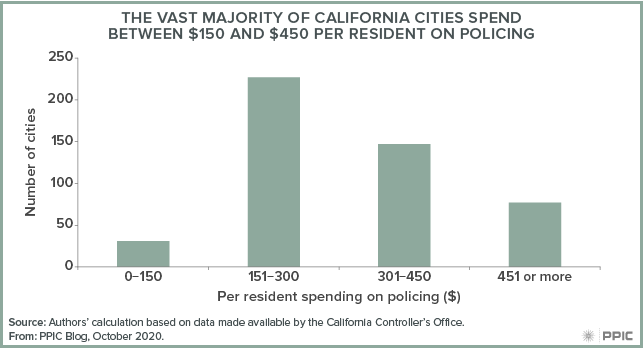Calls to reexamine police funding have become commonplace amid recent protests against racial injustice and the deaths of African Americans at the hands of law enforcement. The amount spent on policing in California is significant: over $20 billion went to local and state law enforcement agencies in 2017–18. Policymakers interested in changing police funding will face numerous considerations, from budgetary restrictions to the effects of the pandemic on government budgets.
Various agencies provide law enforcement services: police departments operate in cities, sheriff’s offices serve non-incorporated parts of counties (while sometimes providing policing services to cities), and the California Highway Patrol is responsible for state and federal highways. California cities spent more than $12.4 billion on policing in the 2017–18 fiscal year. Counties spent $6.2 billion, and the state spent $2.5 billion on the California Highway Patrol.
Here, we focus on police spending in the 482 cities that reported expenditure data for the 2017–18 fiscal year (the most recent data available). More than 80% of the state’s population live in these cities.
Given the large variation in city size, it’s not surprising that there is a wide range in police spending. Los Angeles, the state’s largest city, reported spending over $2.5 billion in 2017–18. At the same time, there were 34 small cities that reported spending less than $1 million each. The median amount was about $8.5 million. Beyond size and location, crime rates and the overall wealth of municipalities may factor into police spending.
The amount spent on policing per resident provides a better comparison across cities. Per resident spending on policing ranges from less than $100 to several thousand dollars. The vast majority of cities spend between $150 and $450.

Police services are the largest category of city spending. The median amount spent on policing is $290 per resident, more than the amount spent on fire protection ($155), parks and recreation ($64), and local streets and roads ($60).
Calls for reallocating funding from police departments often focus on services for those with substance use disorder or mental health challenges. But shifting funds to mental health services or other programs intended to replace law enforcement could be very complicated given that cities and counties are generally responsible for different things. For example, cities are typically responsible for managing services such as law enforcement, fire services, and local parks, while counties are responsible for services like public assistance, public health, and local corrections. County agencies already spend billions of dollars—from a variety of funding sources—on behavioral health services. Additional funding may be necessary if their responsibilities are significantly expanded.
The debate on police funding has also raised questions about whether other service providers are better equipped to handle some types of incidents—like noise complaints or mental health crises—that are currently the purview of law enforcement. For example, city council members in Berkeley have approved a proposal to replace police with unarmed officials for traffic stops.
If local governments move in this direction, policymakers will have to evaluate the best way to set up alternative response systems, which could entail creating new departments and hiring new staff. Alternatively, locals may partner with already established public agencies and programs, but additional new funding will most likely be needed to do so. The possibility of substantial drops in government revenue related to the COVID-19 pandemic make these potential changes even more challenging.
In addition, some of the revenue sources that fund law enforcement services—property, business, and sales taxes; federal and state grants; local fees and fines; and others—have specific spending restrictions. These limitations could present challenges to transferring funds from policing to other areas of government spending.
Despite these many challenges, the current debate on police spending provides a valuable opportunity to reassess community priorities.





